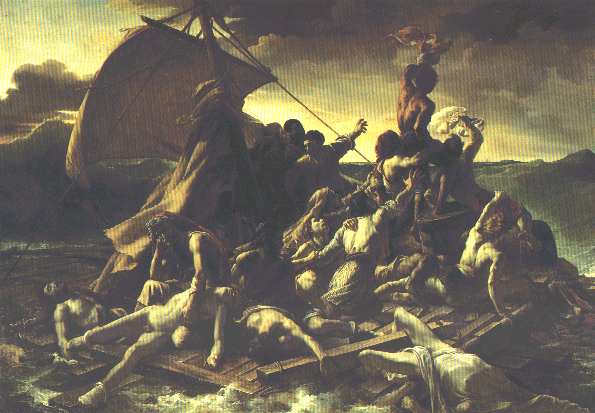A detailed account of Gericault's ideas and working practice with particular reference to The Raft of the Medusa

The start of the work was slow and difficult. The difficulty was to choose from the drama of the shipwreck narrative a single, significant, and pictorially effective moment. Gericault looked at scenes of battle, torment and death in the works of the masters, like Michelangelo, Rubens and Gros, for the appropriate feeling and expression to his subjects.
Gericault began by sketching several alternative moments of the disaster, a procedure which he had used in earlier projects. He was initially drawn to five episodes of Correard's and Savigny's account. They were the Mutiny, Cannibalism, Sighting of the Argus, Hailing the Approaching Rowing-Boat and the Rescue.
Gericault developed their compositions in concrete detail, concentrating on one after the other, testing each thoroughly before going on to the next. Gericault's characteristic habit of building his compositions was by successive additions and transformations and carried the figure motifs from one compositional version to the next.
From Mutiny and Cannibalism's distanced action, Gericault developed his composition of Hailing with the raft close to the foreground as to make the viewer feel transported onto its planks and to involve him in its drama as a participant rather than a detached observer.
From the episode of Hailing, Gericault turned to the Sighting of the Argus. Keeping the main features from the previous work, the Sighting retained the closeness of the Raft to the foreground, the diagonal recession of the whole, the coherence of the figure groups, and their orientation toward a point in the distance. The main change is in the relationship between the Raft and rescue vessel. Throughout Gericault further development of the scene, he steadily intensified the effect of extreme distance between Raft and rescue.
Taking the Sighting scene as his base, Gericault went on to expand his composition unit by unit. He recorded every step of this process in a separate drawing or a painted study. Whenever possible, he borrowed figures from the discarded projects of Mutiny and Cannibalism, for example the group of Father and Son.
Gericault's next step was to give the composition greater unity and to increase its dramatic force. For this effect, he reversed the orientation, making it face to the right.
Gericault tried to give force and clarity to the image's he gathered the figures into four distinct groups. By fusing several bodies in one motion, and by drawing all the figures into a single, strong pattern, he not only avoided confusion but actually turned the number of his figures to compositional advantage.
The division of four dramatic groups determined the entire subsequent composition. The group of dead, dying or despondent men was the core from which the whole composition originally grew and the first group to be fully developed. The four men who stand, alert and watchful, on the other side of the mast form a second group. This group took shape very early and changed little in the further development. The third group composed of men who struggle to rise to their feet. It is the most vividly pantomimic of the groups, Gericault kept modifying these figures until the end, gradually increasing their number from three to five. The fourth group consists of three men who mount some barrels at the Raft's forward end and signal to the Argus. It is the most important of the four groups, that gives a culmination to the dramatic narrative and compositional structure of the Medusa. Yet it is the last that he invented. The Nero's powerful torso stands out against the sky high above the horizon, the cloth unfurling in the wind from his uplifted arm and gives the scene a splendid climax.
Now that the composition was settled, his interest shifted to the Raft's wider setting of water and sky. He improvised a luminous cloudscape and a wide expanse of wind-ploughed sea around the Raft. He had spent half year in preparatory work.
Gericault began execution by transferring the composition to the canvas, producing a huge contour drawing. With the concept of the composition in mind and a contour drawing of it on canvas, he went on directly to execute the figure from life. He posed his models singly, placing each in the proper light and exact position prescribed by the design. Then he painted their bodies into the contours.
Gericault's sketches can be divided into two groups. Ones that accompanied the early compositional designs was to define postures, placements and board areas of light and shade. The later studies from life expresses Gericault's concern with the effects of light, colour and texture during his work on large canvas.
From first to last, Gericault gave his figures, the living and the dead, the appearance of athletes in the vigorous health. His concern with the reality of the event centred throughout on what he regarded as its essential drama, not on its precise aspect.
The special difficulty that he faced in the Medusa was to express the human reality of his subject, its content of terror, anguish and tension. To achieve this realism, he drew and painted many studies from life, as a stimulation and relief. The most astonishing among them are the portraits of dying patients at the Hopital Beaujon, and the still-life of dissected limbs and severed heads, painted in his own studio, where for a time he kept these human fragments to observe and record their gradual decay.
This exposure to death helped him to gain insight for a special authenticity to his work. If his picture was to carry conviction, it had to express genuine experience. He familiarized himself with the sight and smell of death, and tried to live with it day by day, as had the men on the Raft.
Recommended Reading(s):
Eitner, L.
Gericault's Raft of the Medusa Phaidon, 1972
Back to top
Back to Neoclassicism and Romanticism
Back to Home

